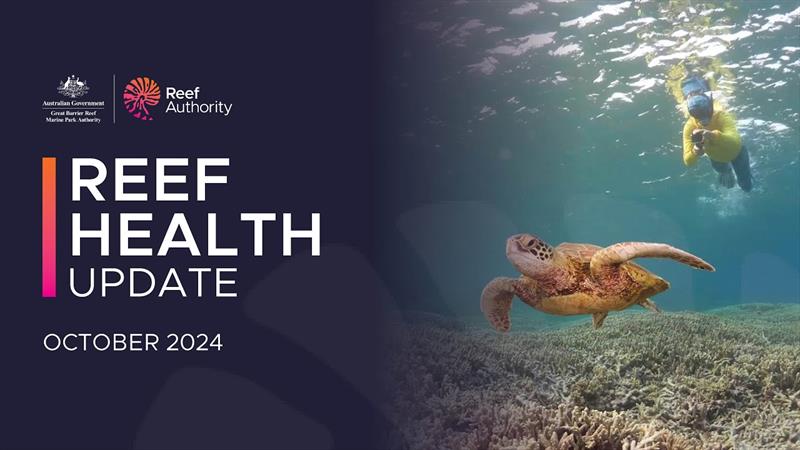
Great Barrier Reef health update - October 2024
by GBRMPA 12 Oct 2024 06:01 BST
October 2024

Great Barrier Reef health update - October 2024 © Great Barrier Reef Marine Park Authority
Global sea-surface temperatures remain above average across most of the planet.
Sea-surface temperatures across the Great Barrier Reef Marine Park are around 0.6 degreesC higher than average for this time of year but these temperatures are not at levels that typically cause impacts such as coral bleaching.
Sea-surface temperatures across the Marine Park are expected to remain from 0.4 to 1.2 degreesC above average from October to December. However, local weather conditions will have a key influence on sea surface temperatures during the summer.
The El Niño-Southern Oscillation weather pattern's neutral condition remains, and the Bureau of Metrology predicts these neutral conditions to continue over the summer.
Reef health summary for September
This Reef Health update is based on data collected during September, 2024.
In September, 348 Reef Health Impact Surveys (RHIS) were conducted across 31 reefs in the Marine Park.
Reef Health Impact Surveys are a quantifiable survey method used mostly by the Reef Authority, Queensland Parks and Wildlife Service and researchers as well as trained tourism operators.
Most reefs surveyed showed no signs of coral bleaching, with very few cases of minor bleaching reported in each region. Any coral bleaching observed is not likely related to current sea-surface temperatures as they are under the levels that would usually cause coral bleaching. The surveys also found minor damage (for example, from anchor damage) on some corals but no signs of disease in all regions of the Marine Park.
There was average or below average rainfall reported across all Reef catchments in September.
The highest known crown-of-thorns starfish outbreak densities continue at some reefs in the offshore Southern Region (Swain Reefs) and isolated outbreaks remain on several reefs offshore Townsville and Whitsunday in the Central Region.
The Crown-of-thorns starfish Control Program is in operation, helping us to target those veracious coral predators so we can support the recovery of coral ecosystems and their resilience into the future.
Reef management
The Reef Authority collaborates with science and management institutions to maintain a contemporary understanding of Reef health and the impacts of climate change on the World Heritage Area.
The Australian Institute of Marine Science, the Bureau of Meteorology, CSIRO, and other research institutions continue to deliver monitoring and research that documents the long-term trend of Reef conditions and climate patterns. This includes multiple monitoring programs under the Reef 2050 Integrated Monitoring and Reporting Program.
During the summer months, the Reef is more vulnerable to extreme weather events including cyclones, marine heatwaves and flooding - the effects of which are compounded by climate change.
As we move into the warmer months, there is a lot of work being done with our partners to prepare for summer.
We are also preparing for the upcoming coral spawning, which only occurs a few nights of the year. During this phenomenal event, millions of bundles of coral sperm and eggs are released into the ocean allowing for mass reproduction—a positive sign for Reef renewal and regeneration.
You can do your bit to help protect the Reef by following a few simple steps:
- Use public moorings where available and do not anchor within no-anchoring areas - they are there to protect the coral.
- Where possible, anchor in sand or mud away from corals and other fragile marine environments. Suitable areas often show up as flat and smooth on your sounder.
- Never wrap anchor rope or chain around bommies or large coral heads.
- If anchoring overnight, anchor before nightfall and double-check the swing room.
- Use your sand anchor and reef pick appropriately to minimise damage.
- Motor towards the anchor when hauling it in and retrieve the anchor when the line is vertical.
- If the anchor is caught on a reef, free it by hand wherever possible.
- Do not force the anchor free by motoring forward.
- Keep watch to make sure the anchor isn't dragging.